HA1022 Principals of Financial Markets Group
VerifiedAdded on 2021/05/27
|17
|3670
|18
AI Summary
Contribute Materials
Your contribution can guide someone’s learning journey. Share your
documents today.
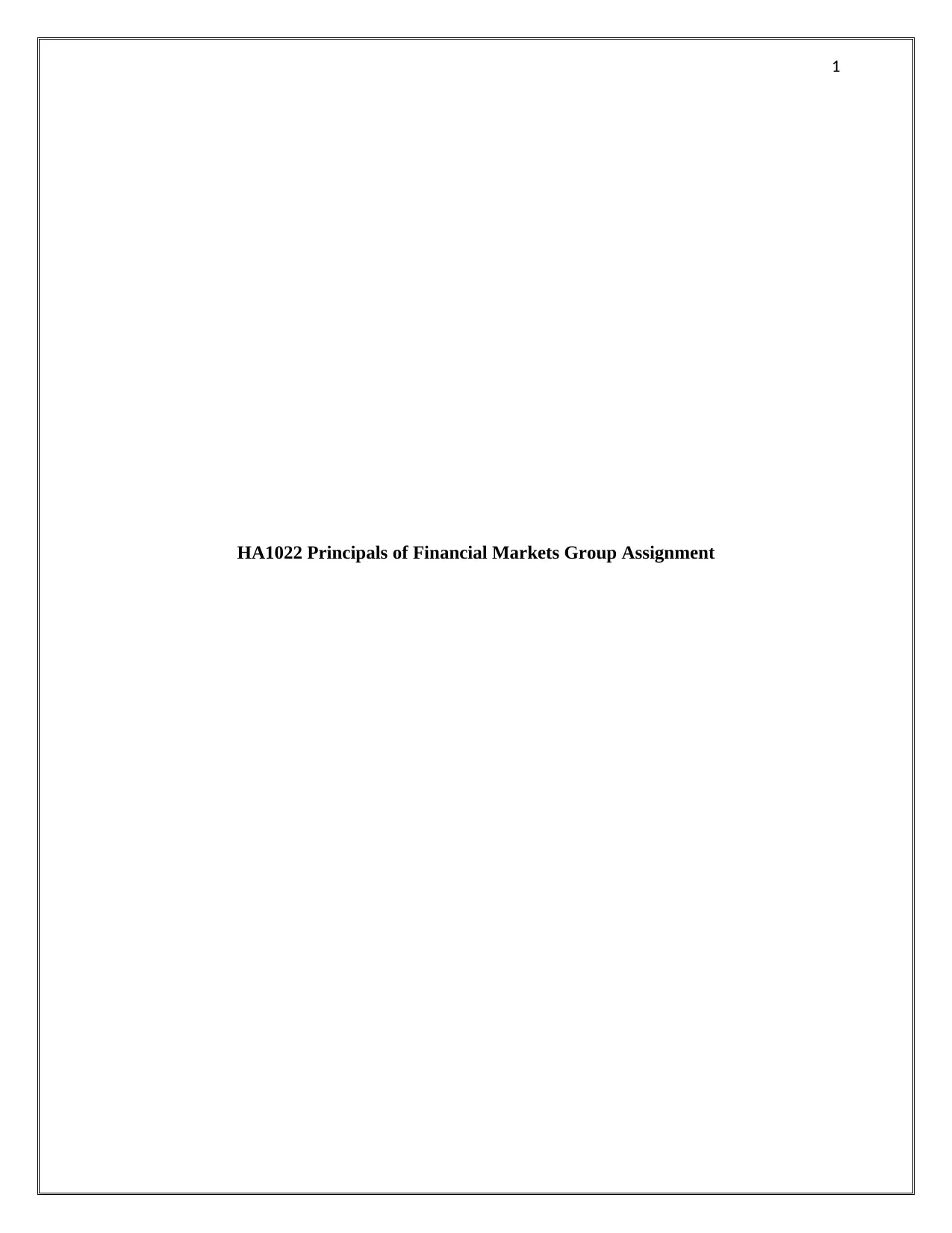
1
HA1022 Principals of Financial Markets Group Assignment
HA1022 Principals of Financial Markets Group Assignment
Secure Best Marks with AI Grader
Need help grading? Try our AI Grader for instant feedback on your assignments.
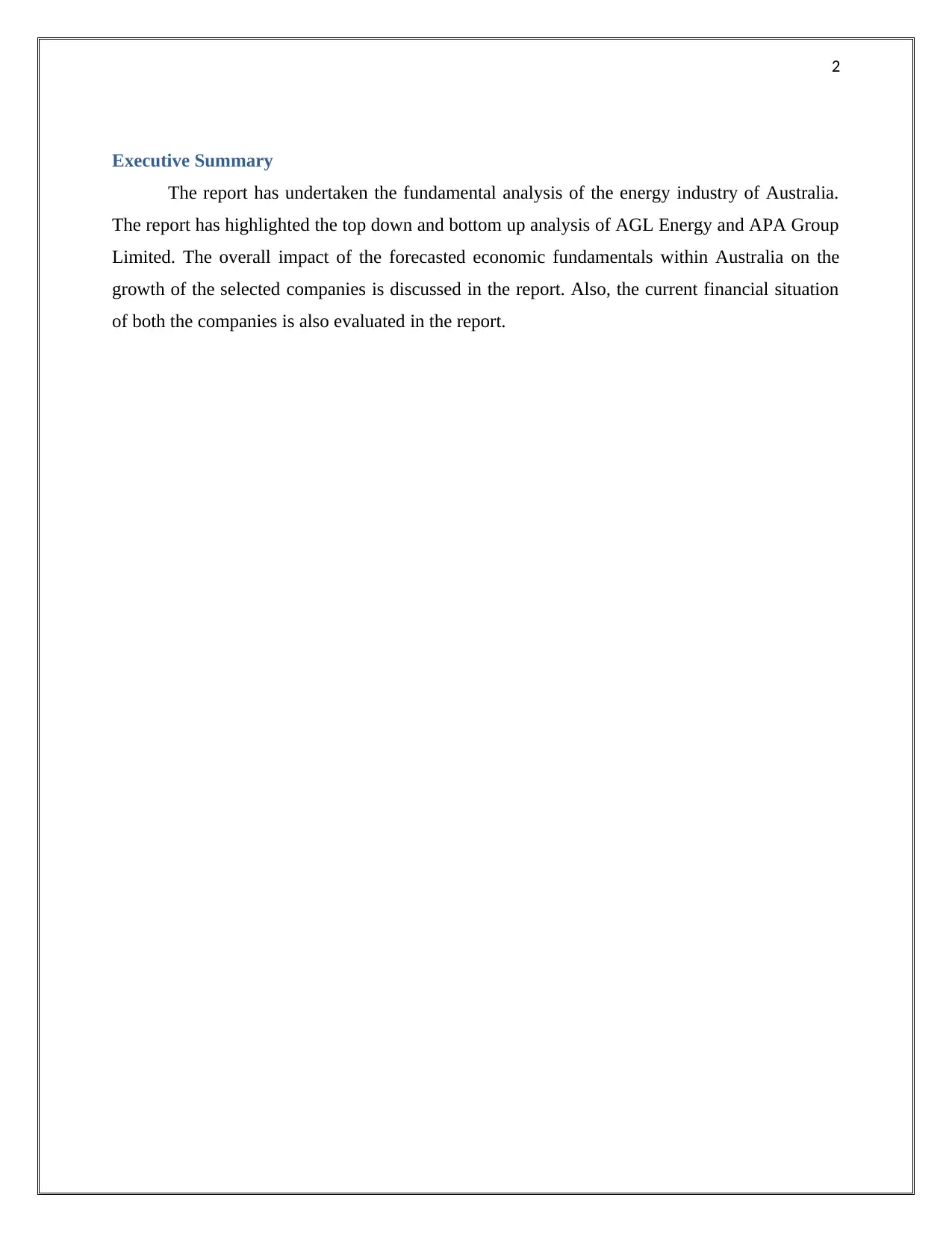
2
Executive Summary
The report has undertaken the fundamental analysis of the energy industry of Australia.
The report has highlighted the top down and bottom up analysis of AGL Energy and APA Group
Limited. The overall impact of the forecasted economic fundamentals within Australia on the
growth of the selected companies is discussed in the report. Also, the current financial situation
of both the companies is also evaluated in the report.
Executive Summary
The report has undertaken the fundamental analysis of the energy industry of Australia.
The report has highlighted the top down and bottom up analysis of AGL Energy and APA Group
Limited. The overall impact of the forecasted economic fundamentals within Australia on the
growth of the selected companies is discussed in the report. Also, the current financial situation
of both the companies is also evaluated in the report.
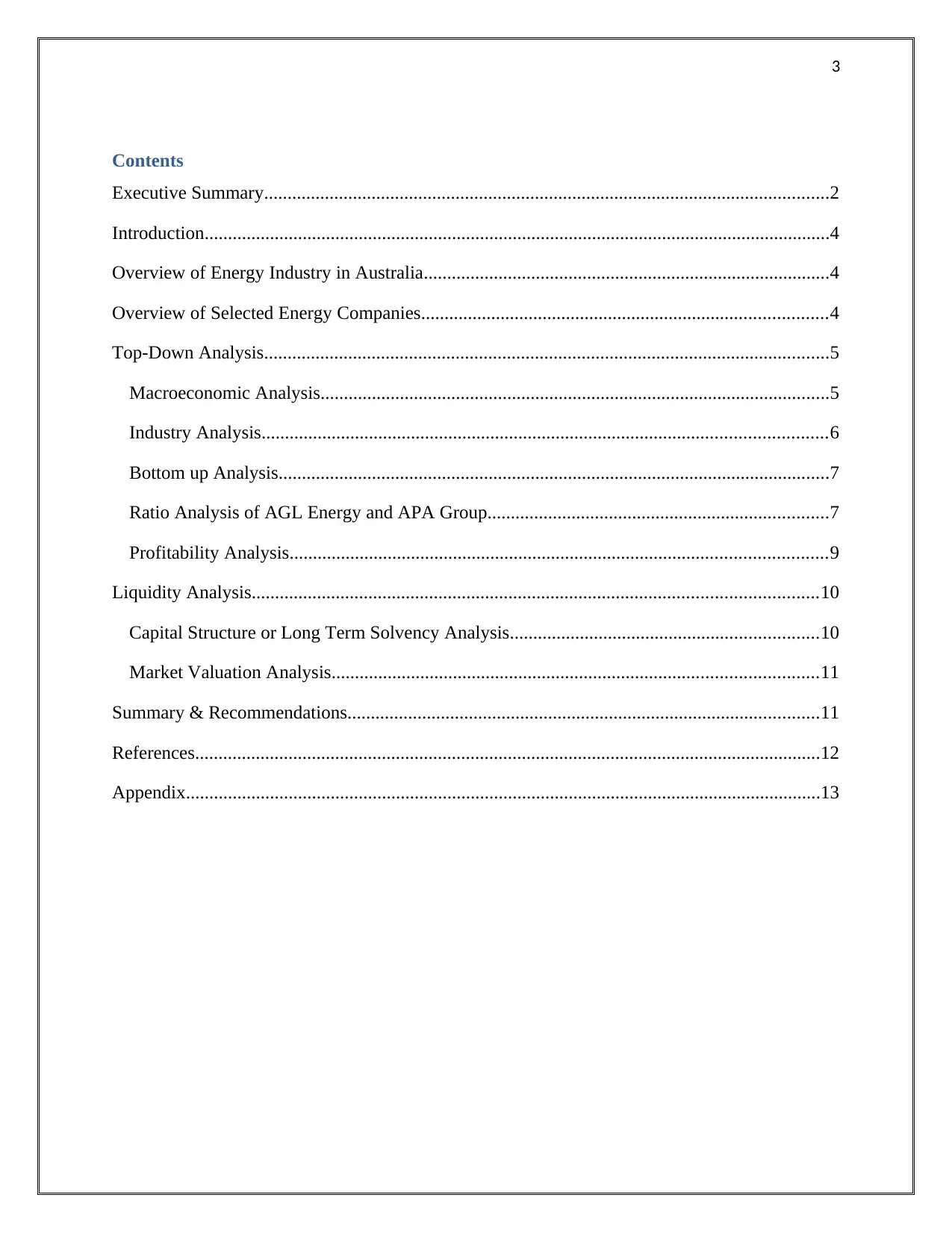
3
Contents
Executive Summary.........................................................................................................................2
Introduction......................................................................................................................................4
Overview of Energy Industry in Australia.......................................................................................4
Overview of Selected Energy Companies.......................................................................................4
Top-Down Analysis.........................................................................................................................5
Macroeconomic Analysis.............................................................................................................5
Industry Analysis.........................................................................................................................6
Bottom up Analysis......................................................................................................................7
Ratio Analysis of AGL Energy and APA Group.........................................................................7
Profitability Analysis...................................................................................................................9
Liquidity Analysis.........................................................................................................................10
Capital Structure or Long Term Solvency Analysis..................................................................10
Market Valuation Analysis........................................................................................................11
Summary & Recommendations.....................................................................................................11
References......................................................................................................................................12
Appendix........................................................................................................................................13
Contents
Executive Summary.........................................................................................................................2
Introduction......................................................................................................................................4
Overview of Energy Industry in Australia.......................................................................................4
Overview of Selected Energy Companies.......................................................................................4
Top-Down Analysis.........................................................................................................................5
Macroeconomic Analysis.............................................................................................................5
Industry Analysis.........................................................................................................................6
Bottom up Analysis......................................................................................................................7
Ratio Analysis of AGL Energy and APA Group.........................................................................7
Profitability Analysis...................................................................................................................9
Liquidity Analysis.........................................................................................................................10
Capital Structure or Long Term Solvency Analysis..................................................................10
Market Valuation Analysis........................................................................................................11
Summary & Recommendations.....................................................................................................11
References......................................................................................................................................12
Appendix........................................................................................................................................13

4
Introduction
The present report is carried out for carrying out fundamental analysis of the two ASX
listed companies operating within the same industry. The fundamental analysis is carried out for
identification of the factors that are likely to implement directional changes in the value of the
two selected companies and also on their share prices. The factors investigated are both macro
and micro in context. The fundamental analysis is carried out with the use of both top down and
bottom up approach. The top-down approach is used for gaining an analysis of the overall
economic environment and considering the impact of the forecasting economic fundamentals on
the performances of the companies selected. The bottom-up analysis is carries for analyzing the
current financial situation of the selected companies. The financial analysis is carried out by
examining the accounting ratios for assessing the company’s performance and its implications
for the industry. The report has carried out fundamental analysis of the two selected energy
companies that are, AGL Energy and APA Group stapled operating in the energy sector of
Australia.
Overview of Energy Industry in Australia
The energy sector of Australia is regarded to be a major contributor of the country’s
economic growth and development. The market capitalization of energy companies in the ASX
200 is estimated to be about $74 billion. The large-scale growth realized by the energy sector of
the country is due to presence of abundance of renewable and non-renewable energy sources.
The higher amount of energy resources within the country is responsible for it being the ninth
largest energy producer across the world. It is estimated that energy sector of the country
accounts for about 2.5 per cent of energy production at a global level and about 5 per cent of
world energy exports. There is presence of major energy producing companies within the sector
completion each other on the basis of market share. The major competitive companies operating
within the sector are Woodside, Origin Energy, Santos, AGL Energy Limited, APA Group
Stapled and many others (Palmer, 2013).
Overview of Selected Energy Companies
AGL Energy Limited
Introduction
The present report is carried out for carrying out fundamental analysis of the two ASX
listed companies operating within the same industry. The fundamental analysis is carried out for
identification of the factors that are likely to implement directional changes in the value of the
two selected companies and also on their share prices. The factors investigated are both macro
and micro in context. The fundamental analysis is carried out with the use of both top down and
bottom up approach. The top-down approach is used for gaining an analysis of the overall
economic environment and considering the impact of the forecasting economic fundamentals on
the performances of the companies selected. The bottom-up analysis is carries for analyzing the
current financial situation of the selected companies. The financial analysis is carried out by
examining the accounting ratios for assessing the company’s performance and its implications
for the industry. The report has carried out fundamental analysis of the two selected energy
companies that are, AGL Energy and APA Group stapled operating in the energy sector of
Australia.
Overview of Energy Industry in Australia
The energy sector of Australia is regarded to be a major contributor of the country’s
economic growth and development. The market capitalization of energy companies in the ASX
200 is estimated to be about $74 billion. The large-scale growth realized by the energy sector of
the country is due to presence of abundance of renewable and non-renewable energy sources.
The higher amount of energy resources within the country is responsible for it being the ninth
largest energy producer across the world. It is estimated that energy sector of the country
accounts for about 2.5 per cent of energy production at a global level and about 5 per cent of
world energy exports. There is presence of major energy producing companies within the sector
completion each other on the basis of market share. The major competitive companies operating
within the sector are Woodside, Origin Energy, Santos, AGL Energy Limited, APA Group
Stapled and many others (Palmer, 2013).
Overview of Selected Energy Companies
AGL Energy Limited
Secure Best Marks with AI Grader
Need help grading? Try our AI Grader for instant feedback on your assignments.
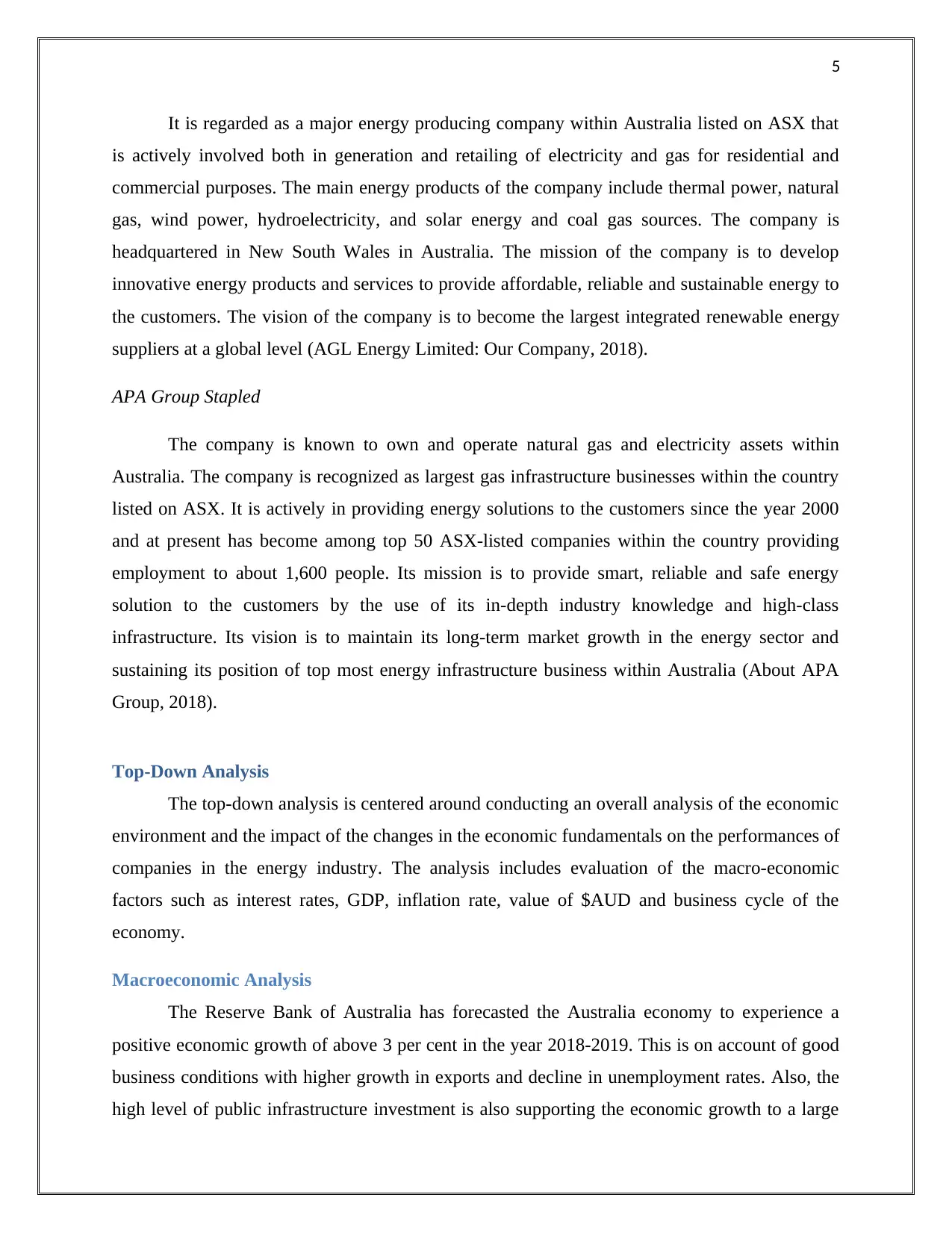
5
It is regarded as a major energy producing company within Australia listed on ASX that
is actively involved both in generation and retailing of electricity and gas for residential and
commercial purposes. The main energy products of the company include thermal power, natural
gas, wind power, hydroelectricity, and solar energy and coal gas sources. The company is
headquartered in New South Wales in Australia. The mission of the company is to develop
innovative energy products and services to provide affordable, reliable and sustainable energy to
the customers. The vision of the company is to become the largest integrated renewable energy
suppliers at a global level (AGL Energy Limited: Our Company, 2018).
APA Group Stapled
The company is known to own and operate natural gas and electricity assets within
Australia. The company is recognized as largest gas infrastructure businesses within the country
listed on ASX. It is actively in providing energy solutions to the customers since the year 2000
and at present has become among top 50 ASX-listed companies within the country providing
employment to about 1,600 people. Its mission is to provide smart, reliable and safe energy
solution to the customers by the use of its in-depth industry knowledge and high-class
infrastructure. Its vision is to maintain its long-term market growth in the energy sector and
sustaining its position of top most energy infrastructure business within Australia (About APA
Group, 2018).
Top-Down Analysis
The top-down analysis is centered around conducting an overall analysis of the economic
environment and the impact of the changes in the economic fundamentals on the performances of
companies in the energy industry. The analysis includes evaluation of the macro-economic
factors such as interest rates, GDP, inflation rate, value of $AUD and business cycle of the
economy.
Macroeconomic Analysis
The Reserve Bank of Australia has forecasted the Australia economy to experience a
positive economic growth of above 3 per cent in the year 2018-2019. This is on account of good
business conditions with higher growth in exports and decline in unemployment rates. Also, the
high level of public infrastructure investment is also supporting the economic growth to a large
It is regarded as a major energy producing company within Australia listed on ASX that
is actively involved both in generation and retailing of electricity and gas for residential and
commercial purposes. The main energy products of the company include thermal power, natural
gas, wind power, hydroelectricity, and solar energy and coal gas sources. The company is
headquartered in New South Wales in Australia. The mission of the company is to develop
innovative energy products and services to provide affordable, reliable and sustainable energy to
the customers. The vision of the company is to become the largest integrated renewable energy
suppliers at a global level (AGL Energy Limited: Our Company, 2018).
APA Group Stapled
The company is known to own and operate natural gas and electricity assets within
Australia. The company is recognized as largest gas infrastructure businesses within the country
listed on ASX. It is actively in providing energy solutions to the customers since the year 2000
and at present has become among top 50 ASX-listed companies within the country providing
employment to about 1,600 people. Its mission is to provide smart, reliable and safe energy
solution to the customers by the use of its in-depth industry knowledge and high-class
infrastructure. Its vision is to maintain its long-term market growth in the energy sector and
sustaining its position of top most energy infrastructure business within Australia (About APA
Group, 2018).
Top-Down Analysis
The top-down analysis is centered around conducting an overall analysis of the economic
environment and the impact of the changes in the economic fundamentals on the performances of
companies in the energy industry. The analysis includes evaluation of the macro-economic
factors such as interest rates, GDP, inflation rate, value of $AUD and business cycle of the
economy.
Macroeconomic Analysis
The Reserve Bank of Australia has forecasted the Australia economy to experience a
positive economic growth of above 3 per cent in the year 2018-2019. This is on account of good
business conditions with higher growth in exports and decline in unemployment rates. Also, the
high level of public infrastructure investment is also supporting the economic growth to a large
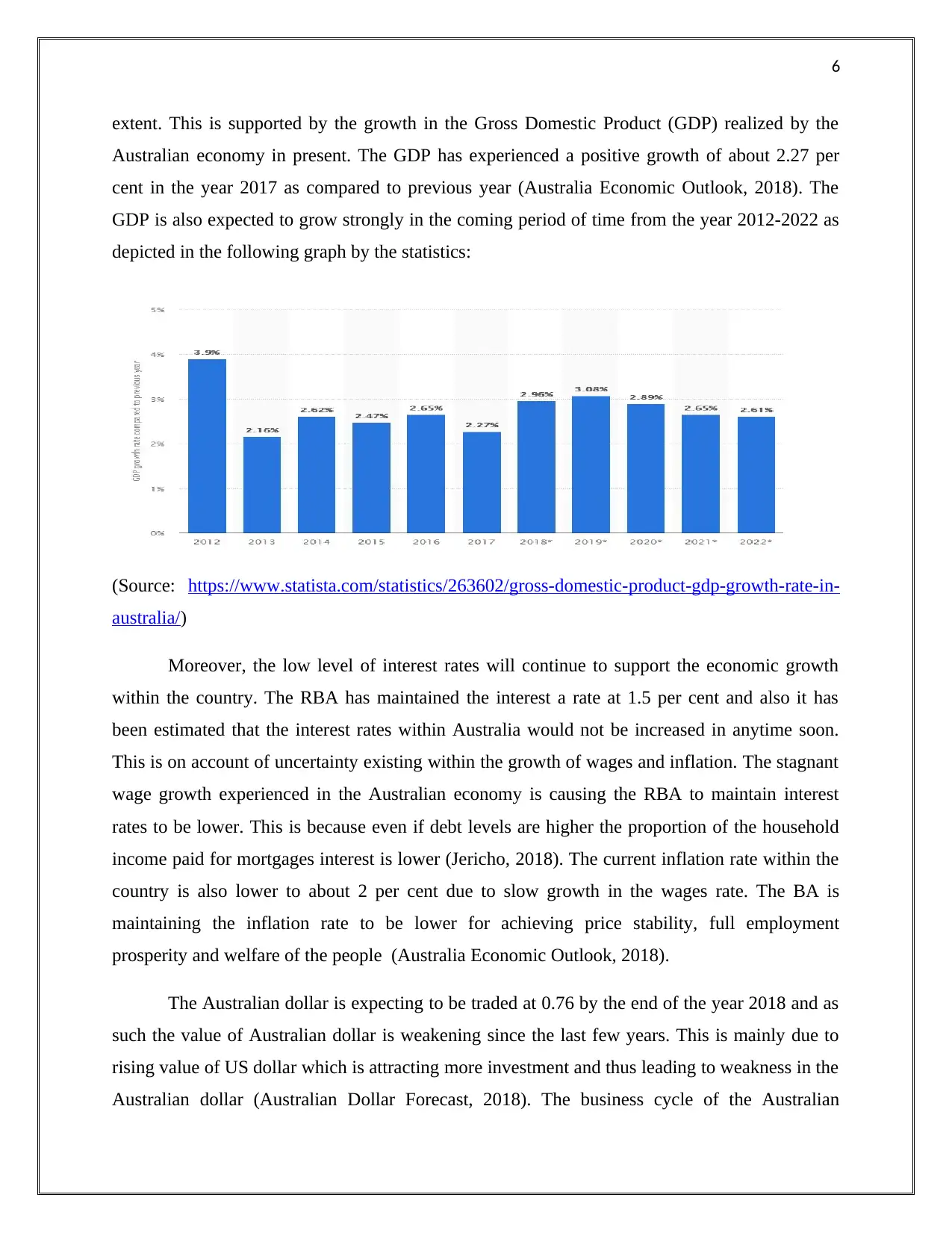
6
extent. This is supported by the growth in the Gross Domestic Product (GDP) realized by the
Australian economy in present. The GDP has experienced a positive growth of about 2.27 per
cent in the year 2017 as compared to previous year (Australia Economic Outlook, 2018). The
GDP is also expected to grow strongly in the coming period of time from the year 2012-2022 as
depicted in the following graph by the statistics:
(Source: https://www.statista.com/statistics/263602/gross-domestic-product-gdp-growth-rate-in-
australia/)
Moreover, the low level of interest rates will continue to support the economic growth
within the country. The RBA has maintained the interest a rate at 1.5 per cent and also it has
been estimated that the interest rates within Australia would not be increased in anytime soon.
This is on account of uncertainty existing within the growth of wages and inflation. The stagnant
wage growth experienced in the Australian economy is causing the RBA to maintain interest
rates to be lower. This is because even if debt levels are higher the proportion of the household
income paid for mortgages interest is lower (Jericho, 2018). The current inflation rate within the
country is also lower to about 2 per cent due to slow growth in the wages rate. The BA is
maintaining the inflation rate to be lower for achieving price stability, full employment
prosperity and welfare of the people (Australia Economic Outlook, 2018).
The Australian dollar is expecting to be traded at 0.76 by the end of the year 2018 and as
such the value of Australian dollar is weakening since the last few years. This is mainly due to
rising value of US dollar which is attracting more investment and thus leading to weakness in the
Australian dollar (Australian Dollar Forecast, 2018). The business cycle of the Australian
extent. This is supported by the growth in the Gross Domestic Product (GDP) realized by the
Australian economy in present. The GDP has experienced a positive growth of about 2.27 per
cent in the year 2017 as compared to previous year (Australia Economic Outlook, 2018). The
GDP is also expected to grow strongly in the coming period of time from the year 2012-2022 as
depicted in the following graph by the statistics:
(Source: https://www.statista.com/statistics/263602/gross-domestic-product-gdp-growth-rate-in-
australia/)
Moreover, the low level of interest rates will continue to support the economic growth
within the country. The RBA has maintained the interest a rate at 1.5 per cent and also it has
been estimated that the interest rates within Australia would not be increased in anytime soon.
This is on account of uncertainty existing within the growth of wages and inflation. The stagnant
wage growth experienced in the Australian economy is causing the RBA to maintain interest
rates to be lower. This is because even if debt levels are higher the proportion of the household
income paid for mortgages interest is lower (Jericho, 2018). The current inflation rate within the
country is also lower to about 2 per cent due to slow growth in the wages rate. The BA is
maintaining the inflation rate to be lower for achieving price stability, full employment
prosperity and welfare of the people (Australia Economic Outlook, 2018).
The Australian dollar is expecting to be traded at 0.76 by the end of the year 2018 and as
such the value of Australian dollar is weakening since the last few years. This is mainly due to
rising value of US dollar which is attracting more investment and thus leading to weakness in the
Australian dollar (Australian Dollar Forecast, 2018). The business cycle of the Australian
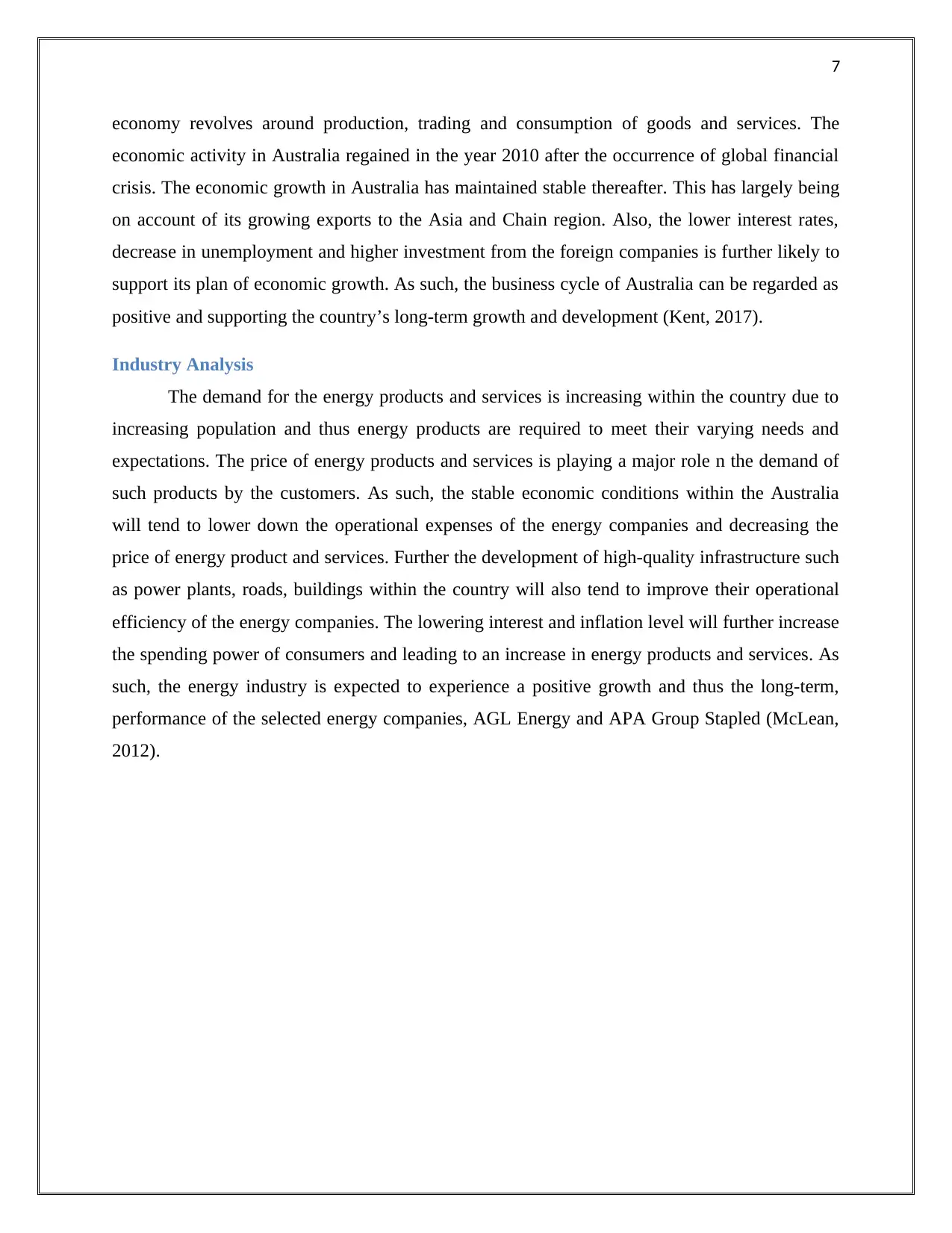
7
economy revolves around production, trading and consumption of goods and services. The
economic activity in Australia regained in the year 2010 after the occurrence of global financial
crisis. The economic growth in Australia has maintained stable thereafter. This has largely being
on account of its growing exports to the Asia and Chain region. Also, the lower interest rates,
decrease in unemployment and higher investment from the foreign companies is further likely to
support its plan of economic growth. As such, the business cycle of Australia can be regarded as
positive and supporting the country’s long-term growth and development (Kent, 2017).
Industry Analysis
The demand for the energy products and services is increasing within the country due to
increasing population and thus energy products are required to meet their varying needs and
expectations. The price of energy products and services is playing a major role n the demand of
such products by the customers. As such, the stable economic conditions within the Australia
will tend to lower down the operational expenses of the energy companies and decreasing the
price of energy product and services. Further the development of high-quality infrastructure such
as power plants, roads, buildings within the country will also tend to improve their operational
efficiency of the energy companies. The lowering interest and inflation level will further increase
the spending power of consumers and leading to an increase in energy products and services. As
such, the energy industry is expected to experience a positive growth and thus the long-term,
performance of the selected energy companies, AGL Energy and APA Group Stapled (McLean,
2012).
economy revolves around production, trading and consumption of goods and services. The
economic activity in Australia regained in the year 2010 after the occurrence of global financial
crisis. The economic growth in Australia has maintained stable thereafter. This has largely being
on account of its growing exports to the Asia and Chain region. Also, the lower interest rates,
decrease in unemployment and higher investment from the foreign companies is further likely to
support its plan of economic growth. As such, the business cycle of Australia can be regarded as
positive and supporting the country’s long-term growth and development (Kent, 2017).
Industry Analysis
The demand for the energy products and services is increasing within the country due to
increasing population and thus energy products are required to meet their varying needs and
expectations. The price of energy products and services is playing a major role n the demand of
such products by the customers. As such, the stable economic conditions within the Australia
will tend to lower down the operational expenses of the energy companies and decreasing the
price of energy product and services. Further the development of high-quality infrastructure such
as power plants, roads, buildings within the country will also tend to improve their operational
efficiency of the energy companies. The lowering interest and inflation level will further increase
the spending power of consumers and leading to an increase in energy products and services. As
such, the energy industry is expected to experience a positive growth and thus the long-term,
performance of the selected energy companies, AGL Energy and APA Group Stapled (McLean,
2012).
Paraphrase This Document
Need a fresh take? Get an instant paraphrase of this document with our AI Paraphraser
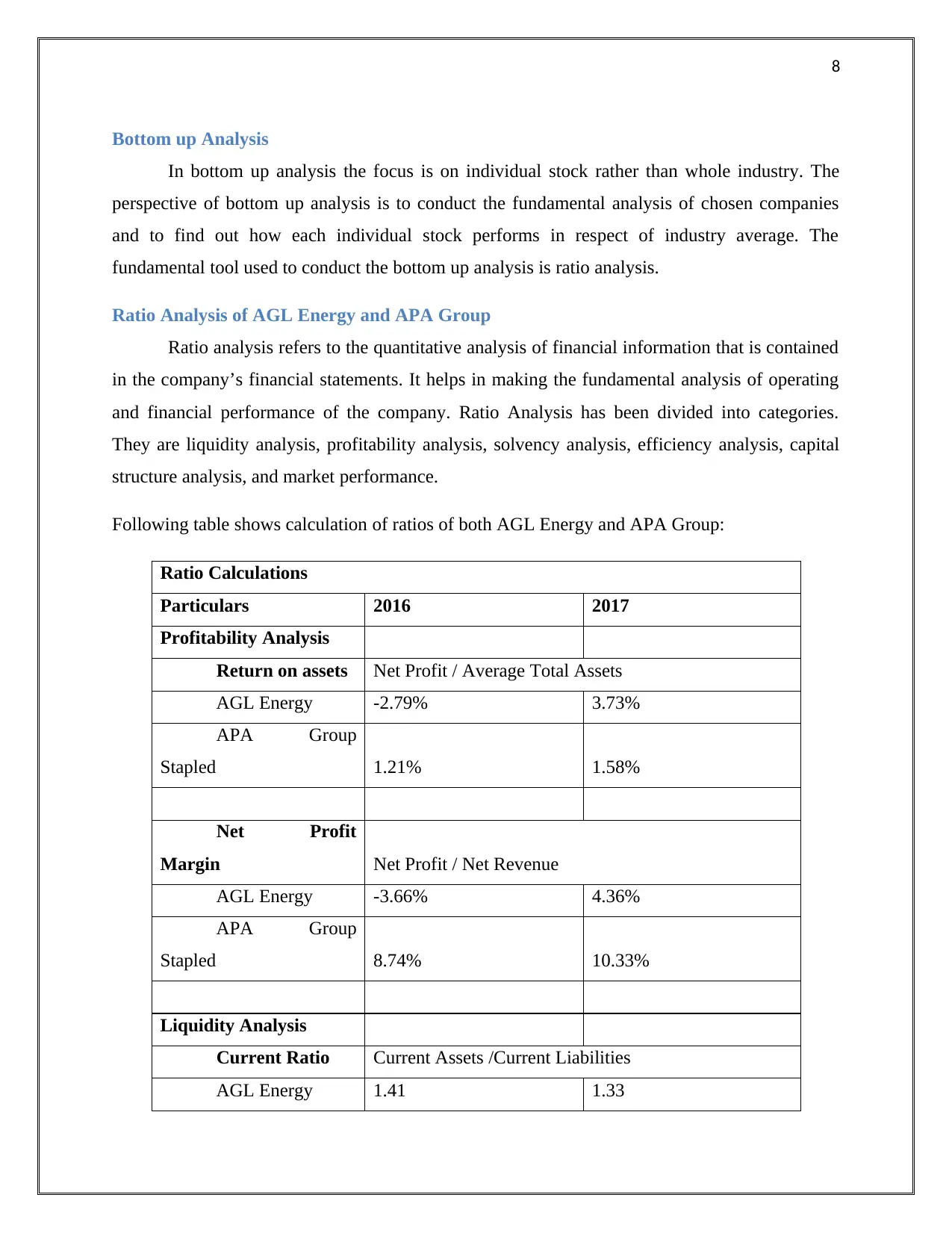
8
Bottom up Analysis
In bottom up analysis the focus is on individual stock rather than whole industry. The
perspective of bottom up analysis is to conduct the fundamental analysis of chosen companies
and to find out how each individual stock performs in respect of industry average. The
fundamental tool used to conduct the bottom up analysis is ratio analysis.
Ratio Analysis of AGL Energy and APA Group
Ratio analysis refers to the quantitative analysis of financial information that is contained
in the company’s financial statements. It helps in making the fundamental analysis of operating
and financial performance of the company. Ratio Analysis has been divided into categories.
They are liquidity analysis, profitability analysis, solvency analysis, efficiency analysis, capital
structure analysis, and market performance.
Following table shows calculation of ratios of both AGL Energy and APA Group:
Ratio Calculations
Particulars 2016 2017
Profitability Analysis
Return on assets Net Profit / Average Total Assets
AGL Energy -2.79% 3.73%
APA Group
Stapled 1.21% 1.58%
Net Profit
Margin Net Profit / Net Revenue
AGL Energy -3.66% 4.36%
APA Group
Stapled 8.74% 10.33%
Liquidity Analysis
Current Ratio Current Assets /Current Liabilities
AGL Energy 1.41 1.33
Bottom up Analysis
In bottom up analysis the focus is on individual stock rather than whole industry. The
perspective of bottom up analysis is to conduct the fundamental analysis of chosen companies
and to find out how each individual stock performs in respect of industry average. The
fundamental tool used to conduct the bottom up analysis is ratio analysis.
Ratio Analysis of AGL Energy and APA Group
Ratio analysis refers to the quantitative analysis of financial information that is contained
in the company’s financial statements. It helps in making the fundamental analysis of operating
and financial performance of the company. Ratio Analysis has been divided into categories.
They are liquidity analysis, profitability analysis, solvency analysis, efficiency analysis, capital
structure analysis, and market performance.
Following table shows calculation of ratios of both AGL Energy and APA Group:
Ratio Calculations
Particulars 2016 2017
Profitability Analysis
Return on assets Net Profit / Average Total Assets
AGL Energy -2.79% 3.73%
APA Group
Stapled 1.21% 1.58%
Net Profit
Margin Net Profit / Net Revenue
AGL Energy -3.66% 4.36%
APA Group
Stapled 8.74% 10.33%
Liquidity Analysis
Current Ratio Current Assets /Current Liabilities
AGL Energy 1.41 1.33
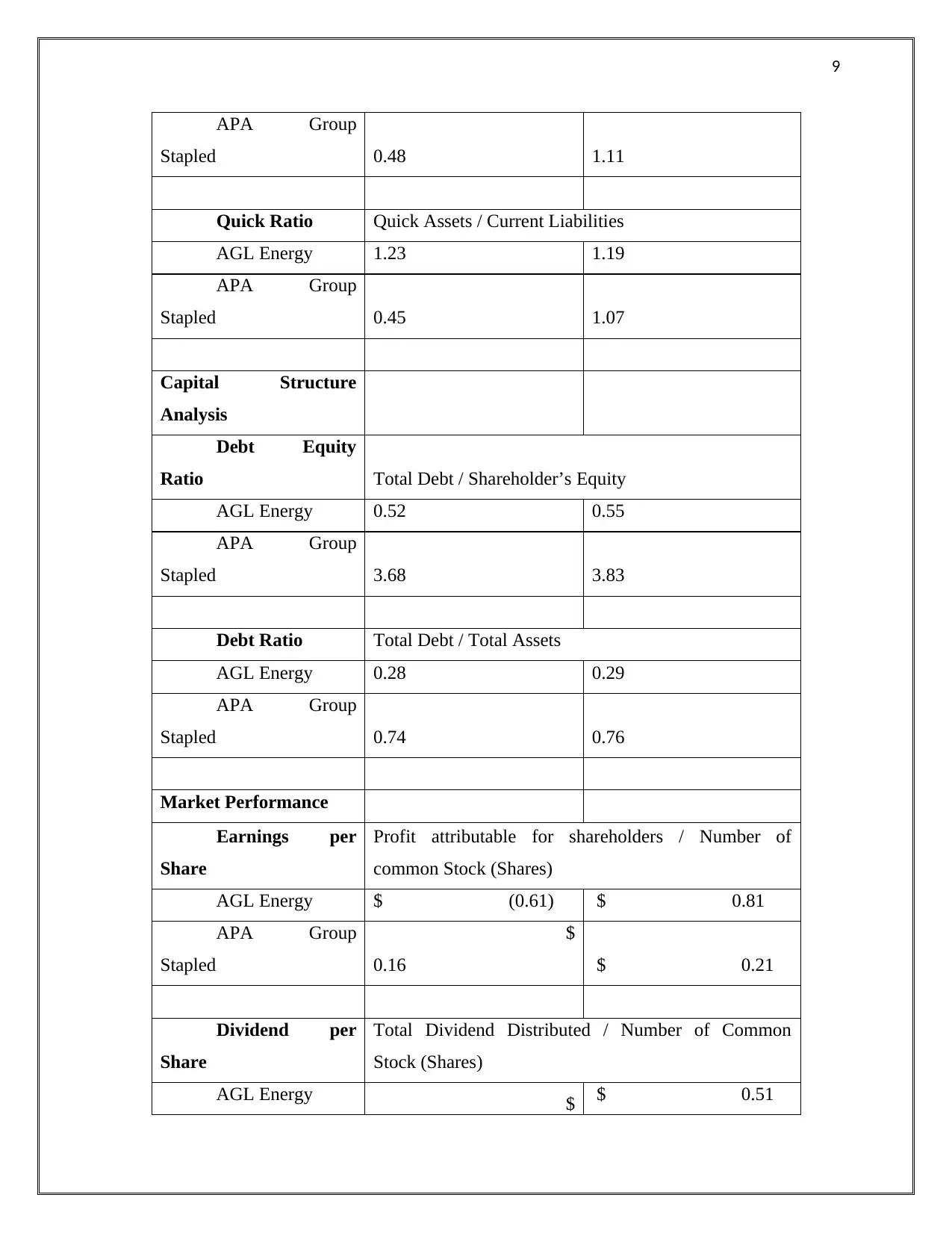
9
APA Group
Stapled 0.48 1.11
Quick Ratio Quick Assets / Current Liabilities
AGL Energy 1.23 1.19
APA Group
Stapled 0.45 1.07
Capital Structure
Analysis
Debt Equity
Ratio Total Debt / Shareholder’s Equity
AGL Energy 0.52 0.55
APA Group
Stapled 3.68 3.83
Debt Ratio Total Debt / Total Assets
AGL Energy 0.28 0.29
APA Group
Stapled 0.74 0.76
Market Performance
Earnings per
Share
Profit attributable for shareholders / Number of
common Stock (Shares)
AGL Energy $ (0.61) $ 0.81
APA Group
Stapled
$
0.16 $ 0.21
Dividend per
Share
Total Dividend Distributed / Number of Common
Stock (Shares)
AGL Energy $ $ 0.51
APA Group
Stapled 0.48 1.11
Quick Ratio Quick Assets / Current Liabilities
AGL Energy 1.23 1.19
APA Group
Stapled 0.45 1.07
Capital Structure
Analysis
Debt Equity
Ratio Total Debt / Shareholder’s Equity
AGL Energy 0.52 0.55
APA Group
Stapled 3.68 3.83
Debt Ratio Total Debt / Total Assets
AGL Energy 0.28 0.29
APA Group
Stapled 0.74 0.76
Market Performance
Earnings per
Share
Profit attributable for shareholders / Number of
common Stock (Shares)
AGL Energy $ (0.61) $ 0.81
APA Group
Stapled
$
0.16 $ 0.21
Dividend per
Share
Total Dividend Distributed / Number of Common
Stock (Shares)
AGL Energy $ $ 0.51
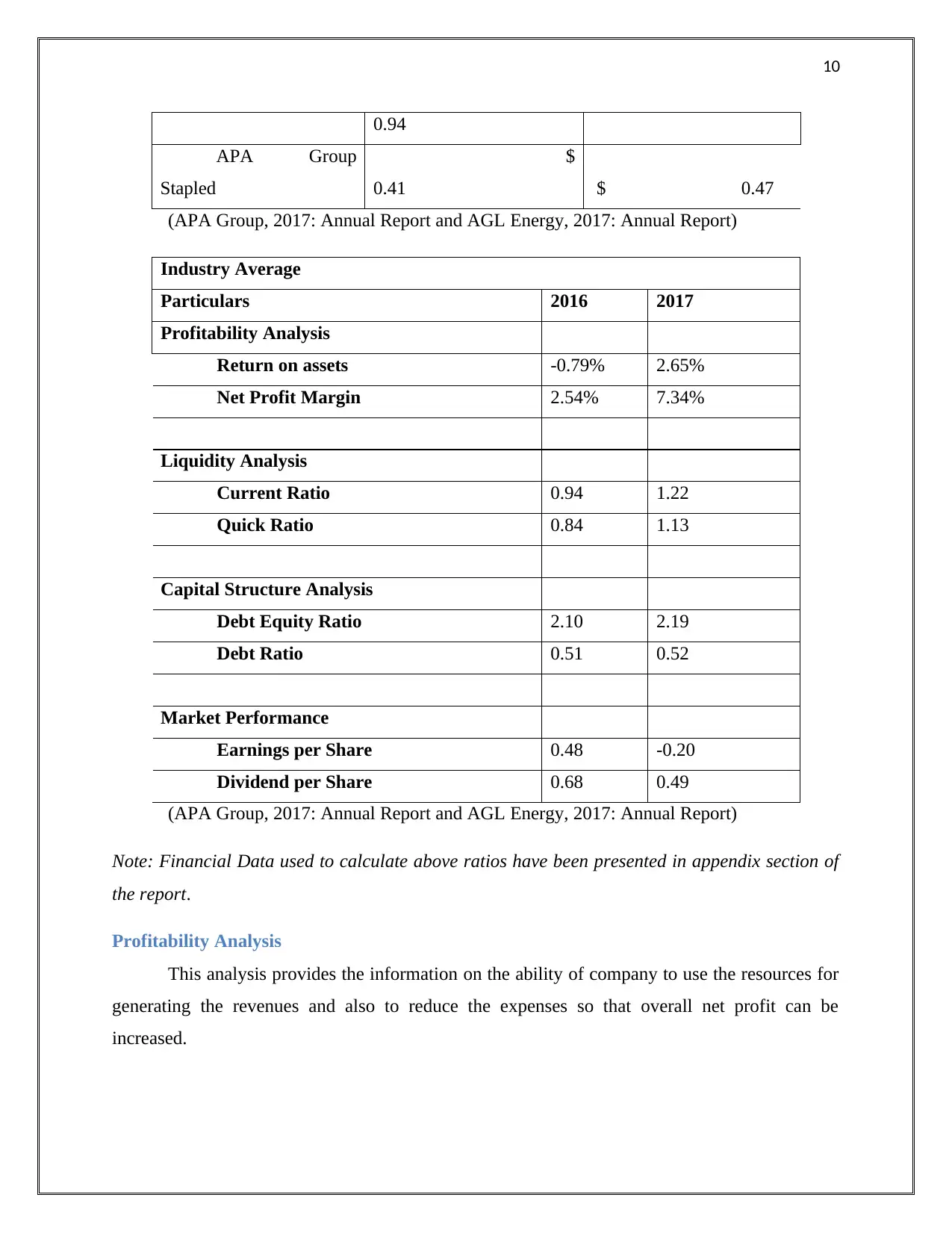
10
0.94
APA Group
Stapled
$
0.41 $ 0.47
(APA Group, 2017: Annual Report and AGL Energy, 2017: Annual Report)
Industry Average
Particulars 2016 2017
Profitability Analysis
Return on assets -0.79% 2.65%
Net Profit Margin 2.54% 7.34%
Liquidity Analysis
Current Ratio 0.94 1.22
Quick Ratio 0.84 1.13
Capital Structure Analysis
Debt Equity Ratio 2.10 2.19
Debt Ratio 0.51 0.52
Market Performance
Earnings per Share 0.48 -0.20
Dividend per Share 0.68 0.49
(APA Group, 2017: Annual Report and AGL Energy, 2017: Annual Report)
Note: Financial Data used to calculate above ratios have been presented in appendix section of
the report.
Profitability Analysis
This analysis provides the information on the ability of company to use the resources for
generating the revenues and also to reduce the expenses so that overall net profit can be
increased.
0.94
APA Group
Stapled
$
0.41 $ 0.47
(APA Group, 2017: Annual Report and AGL Energy, 2017: Annual Report)
Industry Average
Particulars 2016 2017
Profitability Analysis
Return on assets -0.79% 2.65%
Net Profit Margin 2.54% 7.34%
Liquidity Analysis
Current Ratio 0.94 1.22
Quick Ratio 0.84 1.13
Capital Structure Analysis
Debt Equity Ratio 2.10 2.19
Debt Ratio 0.51 0.52
Market Performance
Earnings per Share 0.48 -0.20
Dividend per Share 0.68 0.49
(APA Group, 2017: Annual Report and AGL Energy, 2017: Annual Report)
Note: Financial Data used to calculate above ratios have been presented in appendix section of
the report.
Profitability Analysis
This analysis provides the information on the ability of company to use the resources for
generating the revenues and also to reduce the expenses so that overall net profit can be
increased.
Secure Best Marks with AI Grader
Need help grading? Try our AI Grader for instant feedback on your assignments.
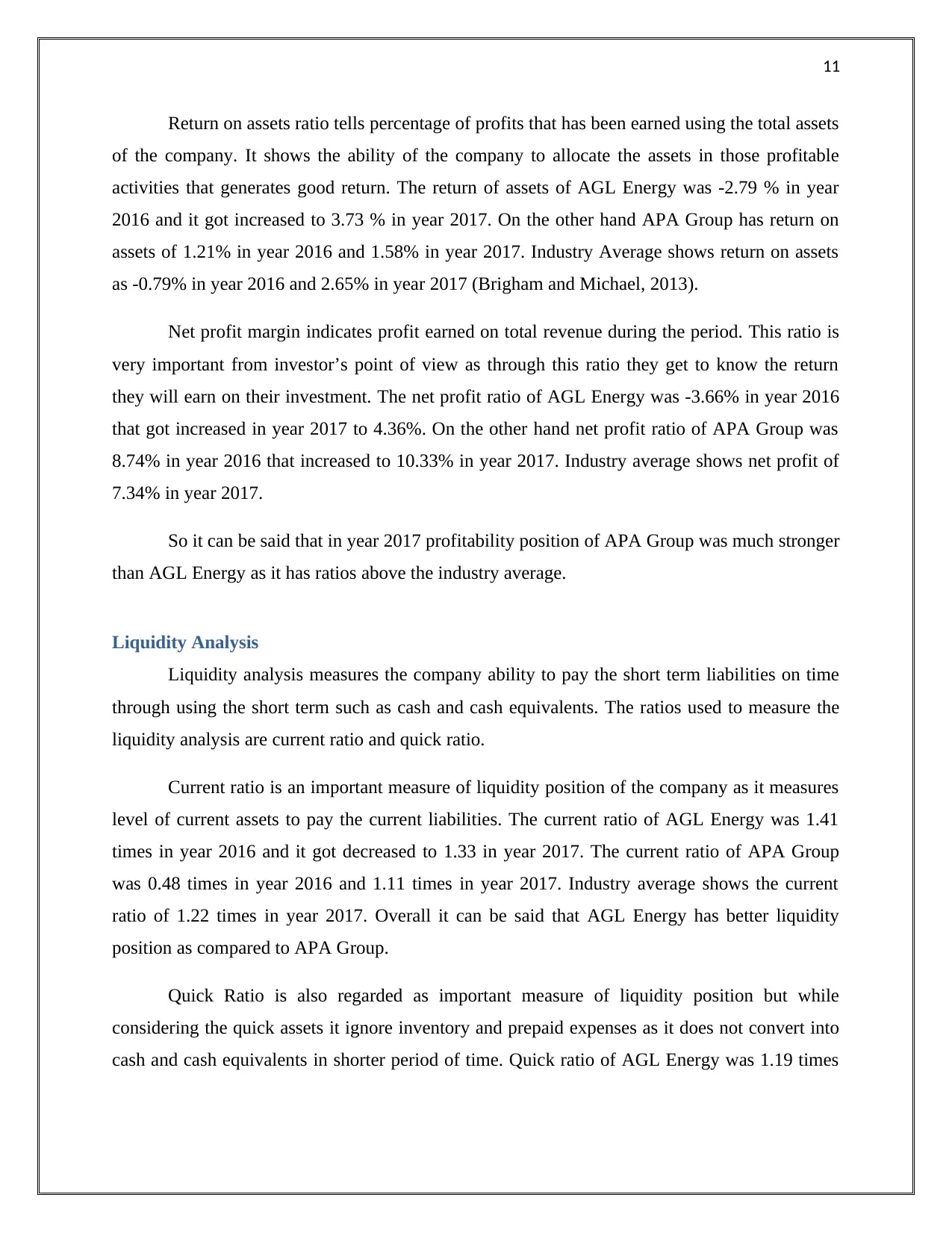
11
Return on assets ratio tells percentage of profits that has been earned using the total assets
of the company. It shows the ability of the company to allocate the assets in those profitable
activities that generates good return. The return of assets of AGL Energy was -2.79 % in year
2016 and it got increased to 3.73 % in year 2017. On the other hand APA Group has return on
assets of 1.21% in year 2016 and 1.58% in year 2017. Industry Average shows return on assets
as -0.79% in year 2016 and 2.65% in year 2017 (Brigham and Michael, 2013).
Net profit margin indicates profit earned on total revenue during the period. This ratio is
very important from investor’s point of view as through this ratio they get to know the return
they will earn on their investment. The net profit ratio of AGL Energy was -3.66% in year 2016
that got increased in year 2017 to 4.36%. On the other hand net profit ratio of APA Group was
8.74% in year 2016 that increased to 10.33% in year 2017. Industry average shows net profit of
7.34% in year 2017.
So it can be said that in year 2017 profitability position of APA Group was much stronger
than AGL Energy as it has ratios above the industry average.
Liquidity Analysis
Liquidity analysis measures the company ability to pay the short term liabilities on time
through using the short term such as cash and cash equivalents. The ratios used to measure the
liquidity analysis are current ratio and quick ratio.
Current ratio is an important measure of liquidity position of the company as it measures
level of current assets to pay the current liabilities. The current ratio of AGL Energy was 1.41
times in year 2016 and it got decreased to 1.33 in year 2017. The current ratio of APA Group
was 0.48 times in year 2016 and 1.11 times in year 2017. Industry average shows the current
ratio of 1.22 times in year 2017. Overall it can be said that AGL Energy has better liquidity
position as compared to APA Group.
Quick Ratio is also regarded as important measure of liquidity position but while
considering the quick assets it ignore inventory and prepaid expenses as it does not convert into
cash and cash equivalents in shorter period of time. Quick ratio of AGL Energy was 1.19 times
Return on assets ratio tells percentage of profits that has been earned using the total assets
of the company. It shows the ability of the company to allocate the assets in those profitable
activities that generates good return. The return of assets of AGL Energy was -2.79 % in year
2016 and it got increased to 3.73 % in year 2017. On the other hand APA Group has return on
assets of 1.21% in year 2016 and 1.58% in year 2017. Industry Average shows return on assets
as -0.79% in year 2016 and 2.65% in year 2017 (Brigham and Michael, 2013).
Net profit margin indicates profit earned on total revenue during the period. This ratio is
very important from investor’s point of view as through this ratio they get to know the return
they will earn on their investment. The net profit ratio of AGL Energy was -3.66% in year 2016
that got increased in year 2017 to 4.36%. On the other hand net profit ratio of APA Group was
8.74% in year 2016 that increased to 10.33% in year 2017. Industry average shows net profit of
7.34% in year 2017.
So it can be said that in year 2017 profitability position of APA Group was much stronger
than AGL Energy as it has ratios above the industry average.
Liquidity Analysis
Liquidity analysis measures the company ability to pay the short term liabilities on time
through using the short term such as cash and cash equivalents. The ratios used to measure the
liquidity analysis are current ratio and quick ratio.
Current ratio is an important measure of liquidity position of the company as it measures
level of current assets to pay the current liabilities. The current ratio of AGL Energy was 1.41
times in year 2016 and it got decreased to 1.33 in year 2017. The current ratio of APA Group
was 0.48 times in year 2016 and 1.11 times in year 2017. Industry average shows the current
ratio of 1.22 times in year 2017. Overall it can be said that AGL Energy has better liquidity
position as compared to APA Group.
Quick Ratio is also regarded as important measure of liquidity position but while
considering the quick assets it ignore inventory and prepaid expenses as it does not convert into
cash and cash equivalents in shorter period of time. Quick ratio of AGL Energy was 1.19 times
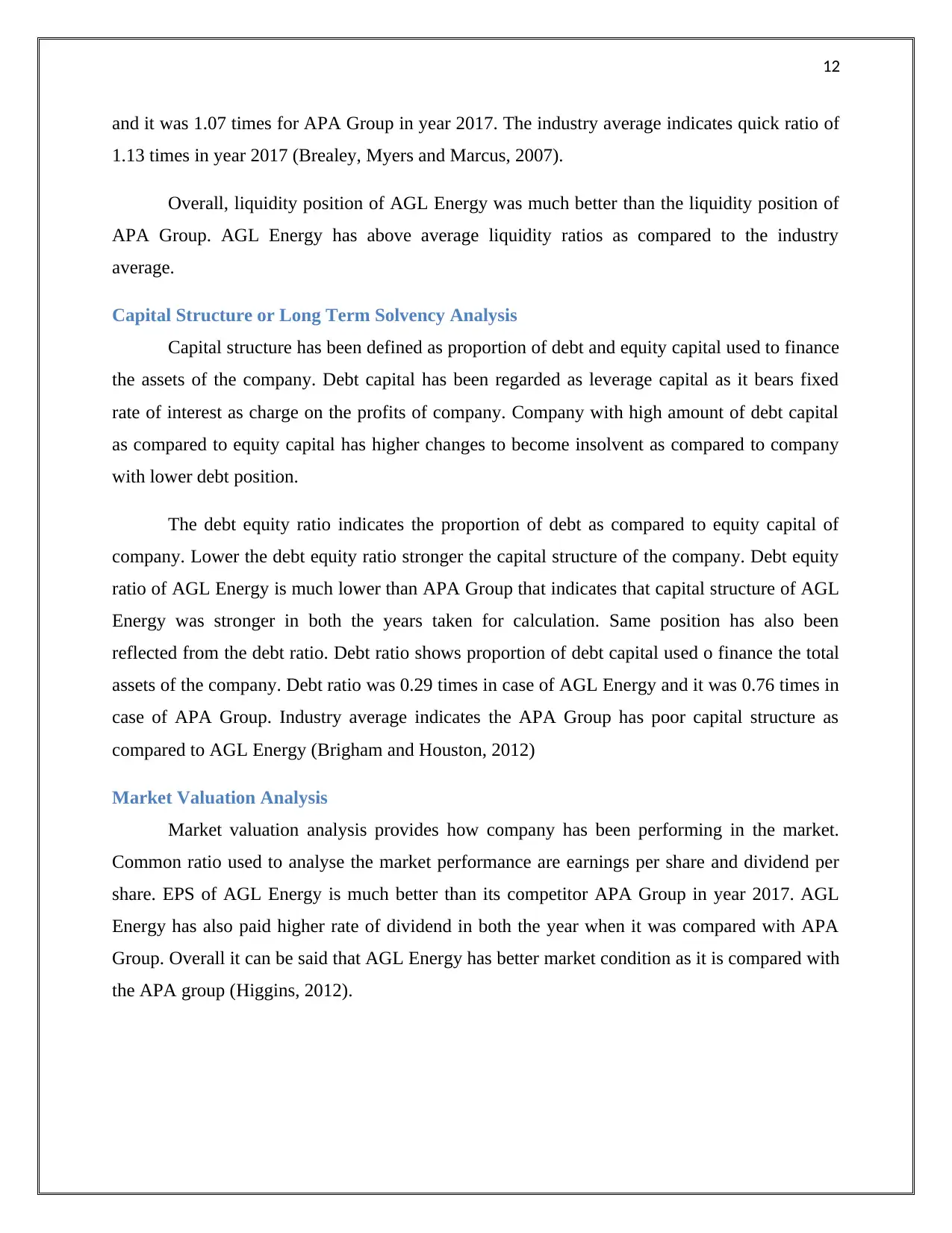
12
and it was 1.07 times for APA Group in year 2017. The industry average indicates quick ratio of
1.13 times in year 2017 (Brealey, Myers and Marcus, 2007).
Overall, liquidity position of AGL Energy was much better than the liquidity position of
APA Group. AGL Energy has above average liquidity ratios as compared to the industry
average.
Capital Structure or Long Term Solvency Analysis
Capital structure has been defined as proportion of debt and equity capital used to finance
the assets of the company. Debt capital has been regarded as leverage capital as it bears fixed
rate of interest as charge on the profits of company. Company with high amount of debt capital
as compared to equity capital has higher changes to become insolvent as compared to company
with lower debt position.
The debt equity ratio indicates the proportion of debt as compared to equity capital of
company. Lower the debt equity ratio stronger the capital structure of the company. Debt equity
ratio of AGL Energy is much lower than APA Group that indicates that capital structure of AGL
Energy was stronger in both the years taken for calculation. Same position has also been
reflected from the debt ratio. Debt ratio shows proportion of debt capital used o finance the total
assets of the company. Debt ratio was 0.29 times in case of AGL Energy and it was 0.76 times in
case of APA Group. Industry average indicates the APA Group has poor capital structure as
compared to AGL Energy (Brigham and Houston, 2012)
Market Valuation Analysis
Market valuation analysis provides how company has been performing in the market.
Common ratio used to analyse the market performance are earnings per share and dividend per
share. EPS of AGL Energy is much better than its competitor APA Group in year 2017. AGL
Energy has also paid higher rate of dividend in both the year when it was compared with APA
Group. Overall it can be said that AGL Energy has better market condition as it is compared with
the APA group (Higgins, 2012).
and it was 1.07 times for APA Group in year 2017. The industry average indicates quick ratio of
1.13 times in year 2017 (Brealey, Myers and Marcus, 2007).
Overall, liquidity position of AGL Energy was much better than the liquidity position of
APA Group. AGL Energy has above average liquidity ratios as compared to the industry
average.
Capital Structure or Long Term Solvency Analysis
Capital structure has been defined as proportion of debt and equity capital used to finance
the assets of the company. Debt capital has been regarded as leverage capital as it bears fixed
rate of interest as charge on the profits of company. Company with high amount of debt capital
as compared to equity capital has higher changes to become insolvent as compared to company
with lower debt position.
The debt equity ratio indicates the proportion of debt as compared to equity capital of
company. Lower the debt equity ratio stronger the capital structure of the company. Debt equity
ratio of AGL Energy is much lower than APA Group that indicates that capital structure of AGL
Energy was stronger in both the years taken for calculation. Same position has also been
reflected from the debt ratio. Debt ratio shows proportion of debt capital used o finance the total
assets of the company. Debt ratio was 0.29 times in case of AGL Energy and it was 0.76 times in
case of APA Group. Industry average indicates the APA Group has poor capital structure as
compared to AGL Energy (Brigham and Houston, 2012)
Market Valuation Analysis
Market valuation analysis provides how company has been performing in the market.
Common ratio used to analyse the market performance are earnings per share and dividend per
share. EPS of AGL Energy is much better than its competitor APA Group in year 2017. AGL
Energy has also paid higher rate of dividend in both the year when it was compared with APA
Group. Overall it can be said that AGL Energy has better market condition as it is compared with
the APA group (Higgins, 2012).
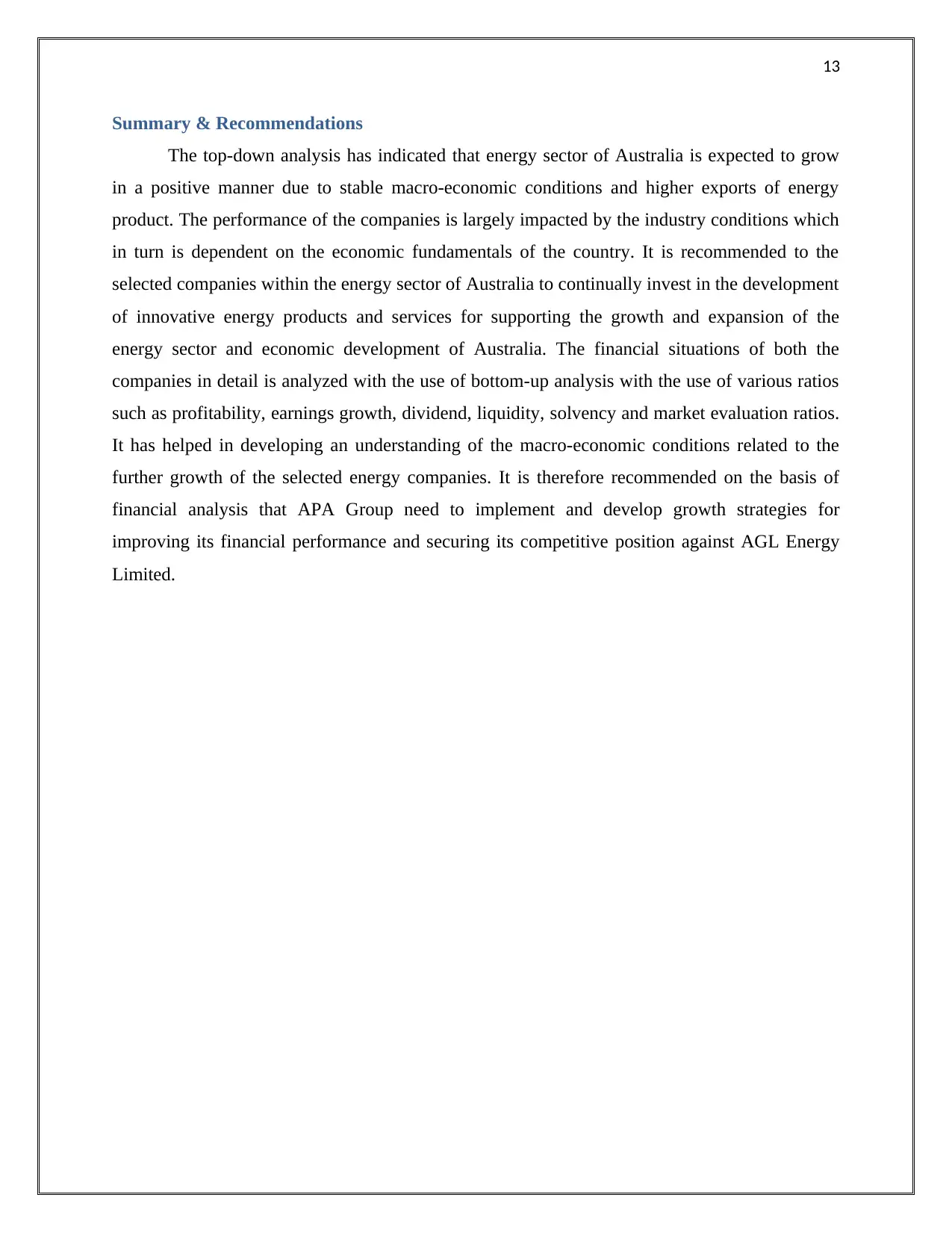
13
Summary & Recommendations
The top-down analysis has indicated that energy sector of Australia is expected to grow
in a positive manner due to stable macro-economic conditions and higher exports of energy
product. The performance of the companies is largely impacted by the industry conditions which
in turn is dependent on the economic fundamentals of the country. It is recommended to the
selected companies within the energy sector of Australia to continually invest in the development
of innovative energy products and services for supporting the growth and expansion of the
energy sector and economic development of Australia. The financial situations of both the
companies in detail is analyzed with the use of bottom-up analysis with the use of various ratios
such as profitability, earnings growth, dividend, liquidity, solvency and market evaluation ratios.
It has helped in developing an understanding of the macro-economic conditions related to the
further growth of the selected energy companies. It is therefore recommended on the basis of
financial analysis that APA Group need to implement and develop growth strategies for
improving its financial performance and securing its competitive position against AGL Energy
Limited.
Summary & Recommendations
The top-down analysis has indicated that energy sector of Australia is expected to grow
in a positive manner due to stable macro-economic conditions and higher exports of energy
product. The performance of the companies is largely impacted by the industry conditions which
in turn is dependent on the economic fundamentals of the country. It is recommended to the
selected companies within the energy sector of Australia to continually invest in the development
of innovative energy products and services for supporting the growth and expansion of the
energy sector and economic development of Australia. The financial situations of both the
companies in detail is analyzed with the use of bottom-up analysis with the use of various ratios
such as profitability, earnings growth, dividend, liquidity, solvency and market evaluation ratios.
It has helped in developing an understanding of the macro-economic conditions related to the
further growth of the selected energy companies. It is therefore recommended on the basis of
financial analysis that APA Group need to implement and develop growth strategies for
improving its financial performance and securing its competitive position against AGL Energy
Limited.
Paraphrase This Document
Need a fresh take? Get an instant paraphrase of this document with our AI Paraphraser
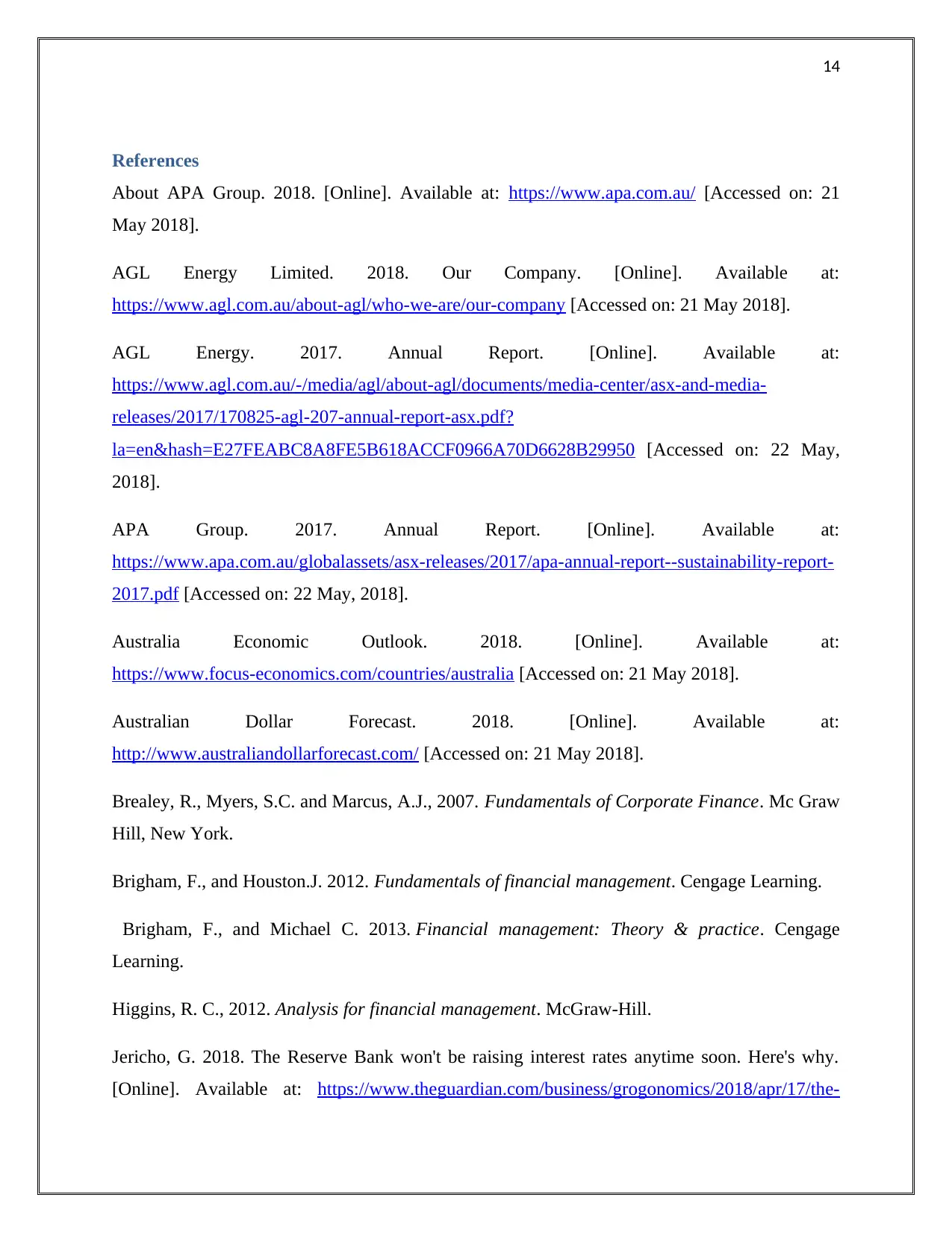
14
References
About APA Group. 2018. [Online]. Available at: https://www.apa.com.au/ [Accessed on: 21
May 2018].
AGL Energy Limited. 2018. Our Company. [Online]. Available at:
https://www.agl.com.au/about-agl/who-we-are/our-company [Accessed on: 21 May 2018].
AGL Energy. 2017. Annual Report. [Online]. Available at:
https://www.agl.com.au/-/media/agl/about-agl/documents/media-center/asx-and-media-
releases/2017/170825-agl-207-annual-report-asx.pdf?
la=en&hash=E27FEABC8A8FE5B618ACCF0966A70D6628B29950 [Accessed on: 22 May,
2018].
APA Group. 2017. Annual Report. [Online]. Available at:
https://www.apa.com.au/globalassets/asx-releases/2017/apa-annual-report--sustainability-report-
2017.pdf [Accessed on: 22 May, 2018].
Australia Economic Outlook. 2018. [Online]. Available at:
https://www.focus-economics.com/countries/australia [Accessed on: 21 May 2018].
Australian Dollar Forecast. 2018. [Online]. Available at:
http://www.australiandollarforecast.com/ [Accessed on: 21 May 2018].
Brealey, R., Myers, S.C. and Marcus, A.J., 2007. Fundamentals of Corporate Finance. Mc Graw
Hill, New York.
Brigham, F., and Houston.J. 2012. Fundamentals of financial management. Cengage Learning.
Brigham, F., and Michael C. 2013. Financial management: Theory & practice. Cengage
Learning.
Higgins, R. C., 2012. Analysis for financial management. McGraw-Hill.
Jericho, G. 2018. The Reserve Bank won't be raising interest rates anytime soon. Here's why.
[Online]. Available at: https://www.theguardian.com/business/grogonomics/2018/apr/17/the-
References
About APA Group. 2018. [Online]. Available at: https://www.apa.com.au/ [Accessed on: 21
May 2018].
AGL Energy Limited. 2018. Our Company. [Online]. Available at:
https://www.agl.com.au/about-agl/who-we-are/our-company [Accessed on: 21 May 2018].
AGL Energy. 2017. Annual Report. [Online]. Available at:
https://www.agl.com.au/-/media/agl/about-agl/documents/media-center/asx-and-media-
releases/2017/170825-agl-207-annual-report-asx.pdf?
la=en&hash=E27FEABC8A8FE5B618ACCF0966A70D6628B29950 [Accessed on: 22 May,
2018].
APA Group. 2017. Annual Report. [Online]. Available at:
https://www.apa.com.au/globalassets/asx-releases/2017/apa-annual-report--sustainability-report-
2017.pdf [Accessed on: 22 May, 2018].
Australia Economic Outlook. 2018. [Online]. Available at:
https://www.focus-economics.com/countries/australia [Accessed on: 21 May 2018].
Australian Dollar Forecast. 2018. [Online]. Available at:
http://www.australiandollarforecast.com/ [Accessed on: 21 May 2018].
Brealey, R., Myers, S.C. and Marcus, A.J., 2007. Fundamentals of Corporate Finance. Mc Graw
Hill, New York.
Brigham, F., and Houston.J. 2012. Fundamentals of financial management. Cengage Learning.
Brigham, F., and Michael C. 2013. Financial management: Theory & practice. Cengage
Learning.
Higgins, R. C., 2012. Analysis for financial management. McGraw-Hill.
Jericho, G. 2018. The Reserve Bank won't be raising interest rates anytime soon. Here's why.
[Online]. Available at: https://www.theguardian.com/business/grogonomics/2018/apr/17/the-
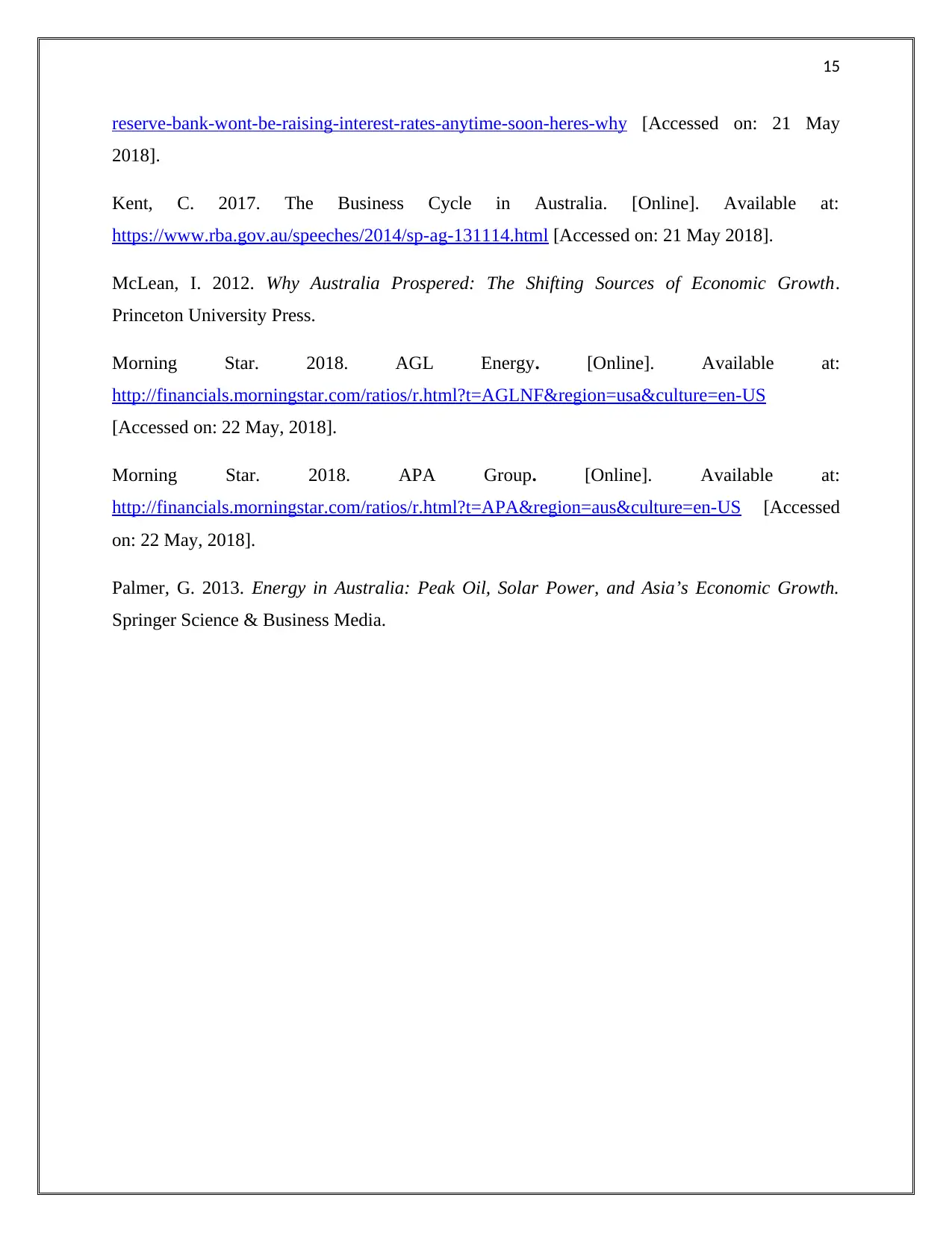
15
reserve-bank-wont-be-raising-interest-rates-anytime-soon-heres-why [Accessed on: 21 May
2018].
Kent, C. 2017. The Business Cycle in Australia. [Online]. Available at:
https://www.rba.gov.au/speeches/2014/sp-ag-131114.html [Accessed on: 21 May 2018].
McLean, I. 2012. Why Australia Prospered: The Shifting Sources of Economic Growth.
Princeton University Press.
Morning Star. 2018. AGL Energy. [Online]. Available at:
http://financials.morningstar.com/ratios/r.html?t=AGLNF®ion=usa&culture=en-US
[Accessed on: 22 May, 2018].
Morning Star. 2018. APA Group. [Online]. Available at:
http://financials.morningstar.com/ratios/r.html?t=APA®ion=aus&culture=en-US [Accessed
on: 22 May, 2018].
Palmer, G. 2013. Energy in Australia: Peak Oil, Solar Power, and Asia’s Economic Growth.
Springer Science & Business Media.
reserve-bank-wont-be-raising-interest-rates-anytime-soon-heres-why [Accessed on: 21 May
2018].
Kent, C. 2017. The Business Cycle in Australia. [Online]. Available at:
https://www.rba.gov.au/speeches/2014/sp-ag-131114.html [Accessed on: 21 May 2018].
McLean, I. 2012. Why Australia Prospered: The Shifting Sources of Economic Growth.
Princeton University Press.
Morning Star. 2018. AGL Energy. [Online]. Available at:
http://financials.morningstar.com/ratios/r.html?t=AGLNF®ion=usa&culture=en-US
[Accessed on: 22 May, 2018].
Morning Star. 2018. APA Group. [Online]. Available at:
http://financials.morningstar.com/ratios/r.html?t=APA®ion=aus&culture=en-US [Accessed
on: 22 May, 2018].
Palmer, G. 2013. Energy in Australia: Peak Oil, Solar Power, and Asia’s Economic Growth.
Springer Science & Business Media.

16
Appendix
Financial Data of AGL Energy (Amount in Million Dollar)
Particulars 2016 2017
Net Profit
$
(408.00)
$
539.00
Total Assets
$
14,604.00
$
14,458.00
Net Revenue
$
11,150.00
$
12,359.00
Current Assets
$
3,587.00
$
3,625.00
Current Liabilities
$
2,553.00
$
2,731.00
Inventory
$
414.00
$
351.00
Prepaid Expenses
$
39.00
$
37.00
Quick Assets
$
3,134.00
$
3,237.00
Total Debts
$
4,136.00
$
4,153.00
Shareholder's Equity 7,915 7,574
Profit attributable for
shareholders
$
(408.00)
$
539.00
Earnings Per Share
$
0.81
$
(0.61)
Number of Equity Shares in
million 675.00 669.00
Payout Ratio in % 0.00% 179.20%
(Morning Star, 2018: AGL Energy)
Appendix
Financial Data of AGL Energy (Amount in Million Dollar)
Particulars 2016 2017
Net Profit
$
(408.00)
$
539.00
Total Assets
$
14,604.00
$
14,458.00
Net Revenue
$
11,150.00
$
12,359.00
Current Assets
$
3,587.00
$
3,625.00
Current Liabilities
$
2,553.00
$
2,731.00
Inventory
$
414.00
$
351.00
Prepaid Expenses
$
39.00
$
37.00
Quick Assets
$
3,134.00
$
3,237.00
Total Debts
$
4,136.00
$
4,153.00
Shareholder's Equity 7,915 7,574
Profit attributable for
shareholders
$
(408.00)
$
539.00
Earnings Per Share
$
0.81
$
(0.61)
Number of Equity Shares in
million 675.00 669.00
Payout Ratio in % 0.00% 179.20%
(Morning Star, 2018: AGL Energy)
Secure Best Marks with AI Grader
Need help grading? Try our AI Grader for instant feedback on your assignments.
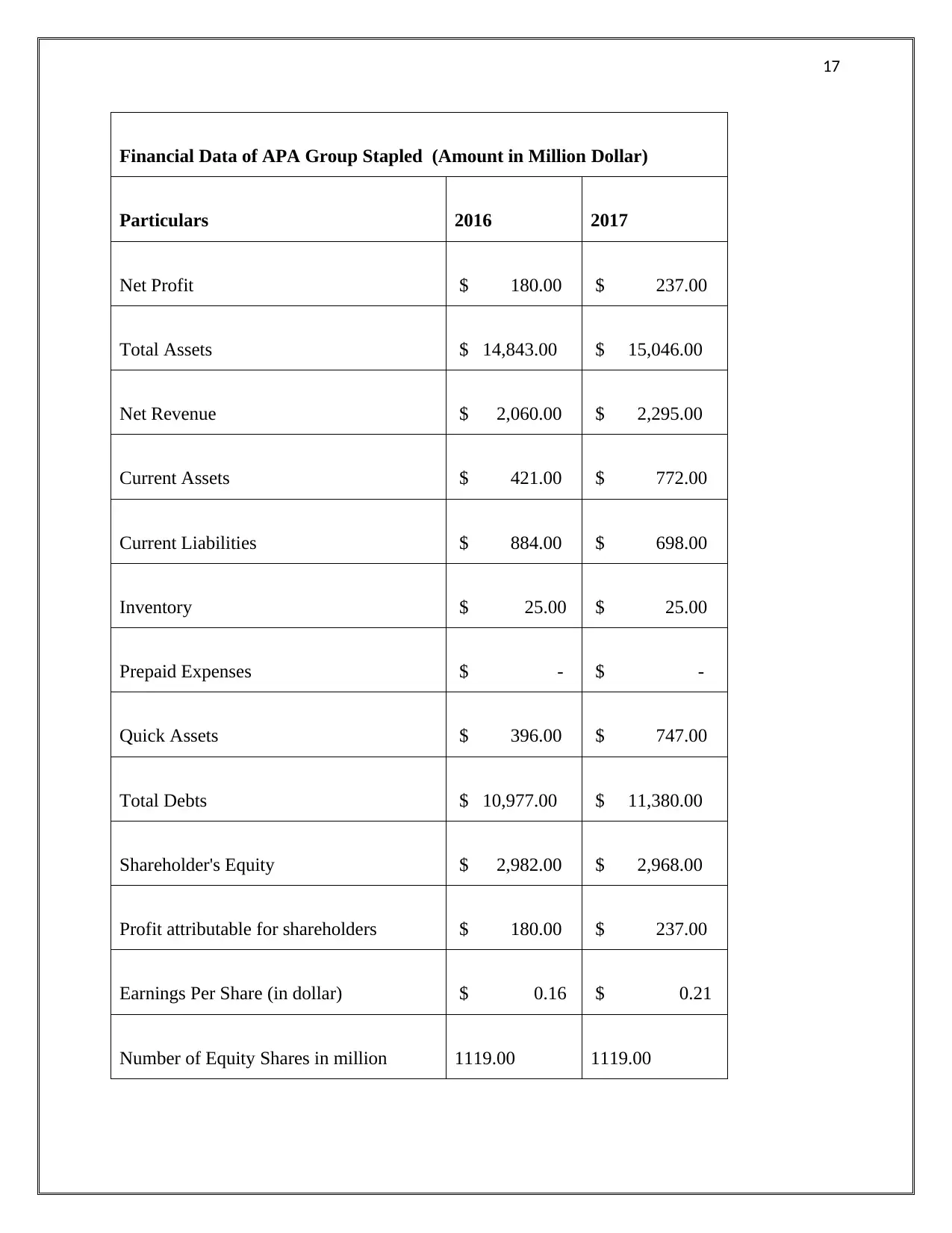
17
Financial Data of APA Group Stapled (Amount in Million Dollar)
Particulars 2016 2017
Net Profit $ 180.00 $ 237.00
Total Assets $ 14,843.00 $ 15,046.00
Net Revenue $ 2,060.00 $ 2,295.00
Current Assets $ 421.00 $ 772.00
Current Liabilities $ 884.00 $ 698.00
Inventory $ 25.00 $ 25.00
Prepaid Expenses $ - $ -
Quick Assets $ 396.00 $ 747.00
Total Debts $ 10,977.00 $ 11,380.00
Shareholder's Equity $ 2,982.00 $ 2,968.00
Profit attributable for shareholders $ 180.00 $ 237.00
Earnings Per Share (in dollar) $ 0.16 $ 0.21
Number of Equity Shares in million 1119.00 1119.00
Financial Data of APA Group Stapled (Amount in Million Dollar)
Particulars 2016 2017
Net Profit $ 180.00 $ 237.00
Total Assets $ 14,843.00 $ 15,046.00
Net Revenue $ 2,060.00 $ 2,295.00
Current Assets $ 421.00 $ 772.00
Current Liabilities $ 884.00 $ 698.00
Inventory $ 25.00 $ 25.00
Prepaid Expenses $ - $ -
Quick Assets $ 396.00 $ 747.00
Total Debts $ 10,977.00 $ 11,380.00
Shareholder's Equity $ 2,982.00 $ 2,968.00
Profit attributable for shareholders $ 180.00 $ 237.00
Earnings Per Share (in dollar) $ 0.16 $ 0.21
Number of Equity Shares in million 1119.00 1119.00
1 out of 17
Related Documents
Your All-in-One AI-Powered Toolkit for Academic Success.
+13062052269
info@desklib.com
Available 24*7 on WhatsApp / Email
![[object Object]](/_next/static/media/star-bottom.7253800d.svg)
Unlock your academic potential
© 2024 | Zucol Services PVT LTD | All rights reserved.





